An Analysis of Pilot Decision-Making in Aviation Meteorology: Essay
VerifiedAdded on 2023/04/23
|8
|2075
|59
Essay
AI Summary
This essay delves into the critical aspects of pilot decision-making within the context of aviation meteorology, with a specific focus on how pilots navigate adverse weather conditions. It begins by reviewing various studies that explore factors influencing pilot decisions, including social pressures and individual expertise, and highlights the importance of understanding Federal Aviation Regulations (FARs). The essay then examines the two-part process of judgment, from categorizing information to reacting to situations, and emphasizes the significance of Aeronautical Decision Making (ADM). The core of the essay focuses on the impact of weather factors like visibility and ceiling, as well as individual factors such as expertise and flight hours, on pilot decision-making. It also explores the five-stage process of developing expertise. Furthermore, the essay discusses various strategies for improving pilot decision-making through training and exposure to diverse weather conditions, emphasizing the role of problem-solving skills and the development of aviation knowledge. In conclusion, the essay underscores the importance of comprehensive weather understanding and the role of training in developing pilots' abilities to make sound decisions in challenging meteorological environments.

Running Head: Aviation Meteorology 1
AVIATION METEOROLOGY
Name
Professor
Institution
Course
Date
AVIATION METEOROLOGY
Name
Professor
Institution
Course
Date
Paraphrase This Document
Need a fresh take? Get an instant paraphrase of this document with our AI Paraphraser

Aviation Meteorology 2
Introduction
This paper significantly reviews various studies conducted to determine what factors
influence pilot decision making on adverse weather conditions. It explores various ways that can
improve pilot decision-making strategies in adverse weather conditions. There are various types
of pilots which include commercial, military, and general aviation (non-military and non-
commercial) who also fly for recreational purposes. General aviation (GA) relates to both
instrument meteorological conditions (IMC) and visual flight rules (VFR) and is likely to record
more fatal accidents. It has been found that factors such as social pressure and individual factors
are more likely to influence pilot decision making in adverse weather conditions. The Federal
Aviation Regulations (FARs) comprises various regulations related to each feature of flight
ranging from the safety of the aircraft to weather situations and airspace limitations
(Administration., 2009).
Pilot decision-making is an important element in a pilot career as it enables one to
understand and make judgments on the underlying weather condition. Literature review from
various researchers describes judgment to comprise of two processes; first the capacity to
categorize and establish all material significant to the underlying task and the capability to react
to the necessary situation (Mark, 2007). The initial section of this process comprises of
comparatively simple decisions, for instance, verifying weather situations at a specific airport
before departure. The second part involves intellectual judgments where the aviator decides how
to utilize best the initially acquired information of the initial stage during the assortment period.
In this stage, other factors such as social pressure, personal values and emotional response are
also considered. Dogo and Deaton (2014) assert that research indicates that accidents about 80%
Introduction
This paper significantly reviews various studies conducted to determine what factors
influence pilot decision making on adverse weather conditions. It explores various ways that can
improve pilot decision-making strategies in adverse weather conditions. There are various types
of pilots which include commercial, military, and general aviation (non-military and non-
commercial) who also fly for recreational purposes. General aviation (GA) relates to both
instrument meteorological conditions (IMC) and visual flight rules (VFR) and is likely to record
more fatal accidents. It has been found that factors such as social pressure and individual factors
are more likely to influence pilot decision making in adverse weather conditions. The Federal
Aviation Regulations (FARs) comprises various regulations related to each feature of flight
ranging from the safety of the aircraft to weather situations and airspace limitations
(Administration., 2009).
Pilot decision-making is an important element in a pilot career as it enables one to
understand and make judgments on the underlying weather condition. Literature review from
various researchers describes judgment to comprise of two processes; first the capacity to
categorize and establish all material significant to the underlying task and the capability to react
to the necessary situation (Mark, 2007). The initial section of this process comprises of
comparatively simple decisions, for instance, verifying weather situations at a specific airport
before departure. The second part involves intellectual judgments where the aviator decides how
to utilize best the initially acquired information of the initial stage during the assortment period.
In this stage, other factors such as social pressure, personal values and emotional response are
also considered. Dogo and Deaton (2014) assert that research indicates that accidents about 80%
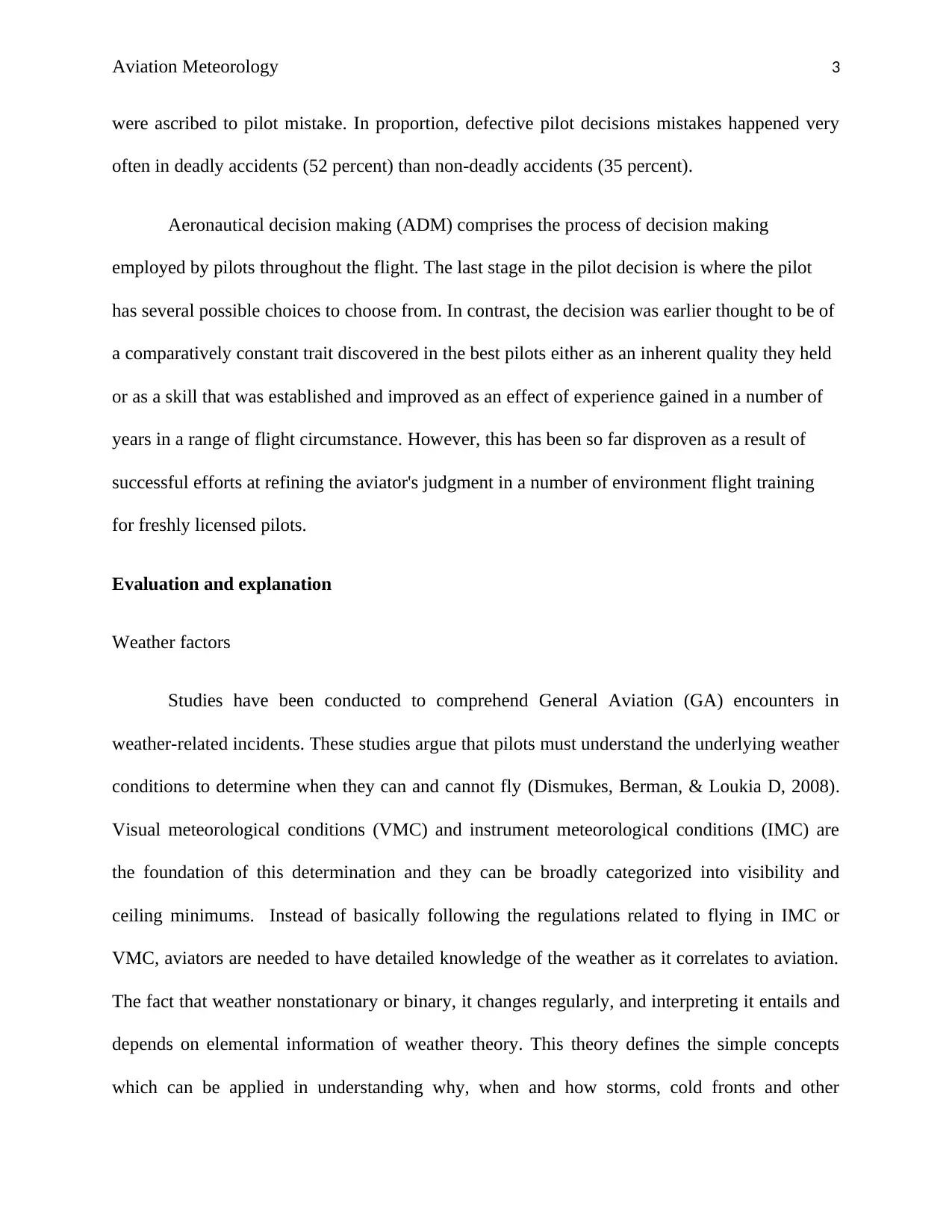
Aviation Meteorology 3
were ascribed to pilot mistake. In proportion, defective pilot decisions mistakes happened very
often in deadly accidents (52 percent) than non-deadly accidents (35 percent).
Aeronautical decision making (ADM) comprises the process of decision making
employed by pilots throughout the flight. The last stage in the pilot decision is where the pilot
has several possible choices to choose from. In contrast, the decision was earlier thought to be of
a comparatively constant trait discovered in the best pilots either as an inherent quality they held
or as a skill that was established and improved as an effect of experience gained in a number of
years in a range of flight circumstance. However, this has been so far disproven as a result of
successful efforts at refining the aviator's judgment in a number of environment flight training
for freshly licensed pilots.
Evaluation and explanation
Weather factors
Studies have been conducted to comprehend General Aviation (GA) encounters in
weather-related incidents. These studies argue that pilots must understand the underlying weather
conditions to determine when they can and cannot fly (Dismukes, Berman, & Loukia D, 2008).
Visual meteorological conditions (VMC) and instrument meteorological conditions (IMC) are
the foundation of this determination and they can be broadly categorized into visibility and
ceiling minimums. Instead of basically following the regulations related to flying in IMC or
VMC, aviators are needed to have detailed knowledge of the weather as it correlates to aviation.
The fact that weather nonstationary or binary, it changes regularly, and interpreting it entails and
depends on elemental information of weather theory. This theory defines the simple concepts
which can be applied in understanding why, when and how storms, cold fronts and other
were ascribed to pilot mistake. In proportion, defective pilot decisions mistakes happened very
often in deadly accidents (52 percent) than non-deadly accidents (35 percent).
Aeronautical decision making (ADM) comprises the process of decision making
employed by pilots throughout the flight. The last stage in the pilot decision is where the pilot
has several possible choices to choose from. In contrast, the decision was earlier thought to be of
a comparatively constant trait discovered in the best pilots either as an inherent quality they held
or as a skill that was established and improved as an effect of experience gained in a number of
years in a range of flight circumstance. However, this has been so far disproven as a result of
successful efforts at refining the aviator's judgment in a number of environment flight training
for freshly licensed pilots.
Evaluation and explanation
Weather factors
Studies have been conducted to comprehend General Aviation (GA) encounters in
weather-related incidents. These studies argue that pilots must understand the underlying weather
conditions to determine when they can and cannot fly (Dismukes, Berman, & Loukia D, 2008).
Visual meteorological conditions (VMC) and instrument meteorological conditions (IMC) are
the foundation of this determination and they can be broadly categorized into visibility and
ceiling minimums. Instead of basically following the regulations related to flying in IMC or
VMC, aviators are needed to have detailed knowledge of the weather as it correlates to aviation.
The fact that weather nonstationary or binary, it changes regularly, and interpreting it entails and
depends on elemental information of weather theory. This theory defines the simple concepts
which can be applied in understanding why, when and how storms, cold fronts and other
⊘ This is a preview!⊘
Do you want full access?
Subscribe today to unlock all pages.

Trusted by 1+ million students worldwide
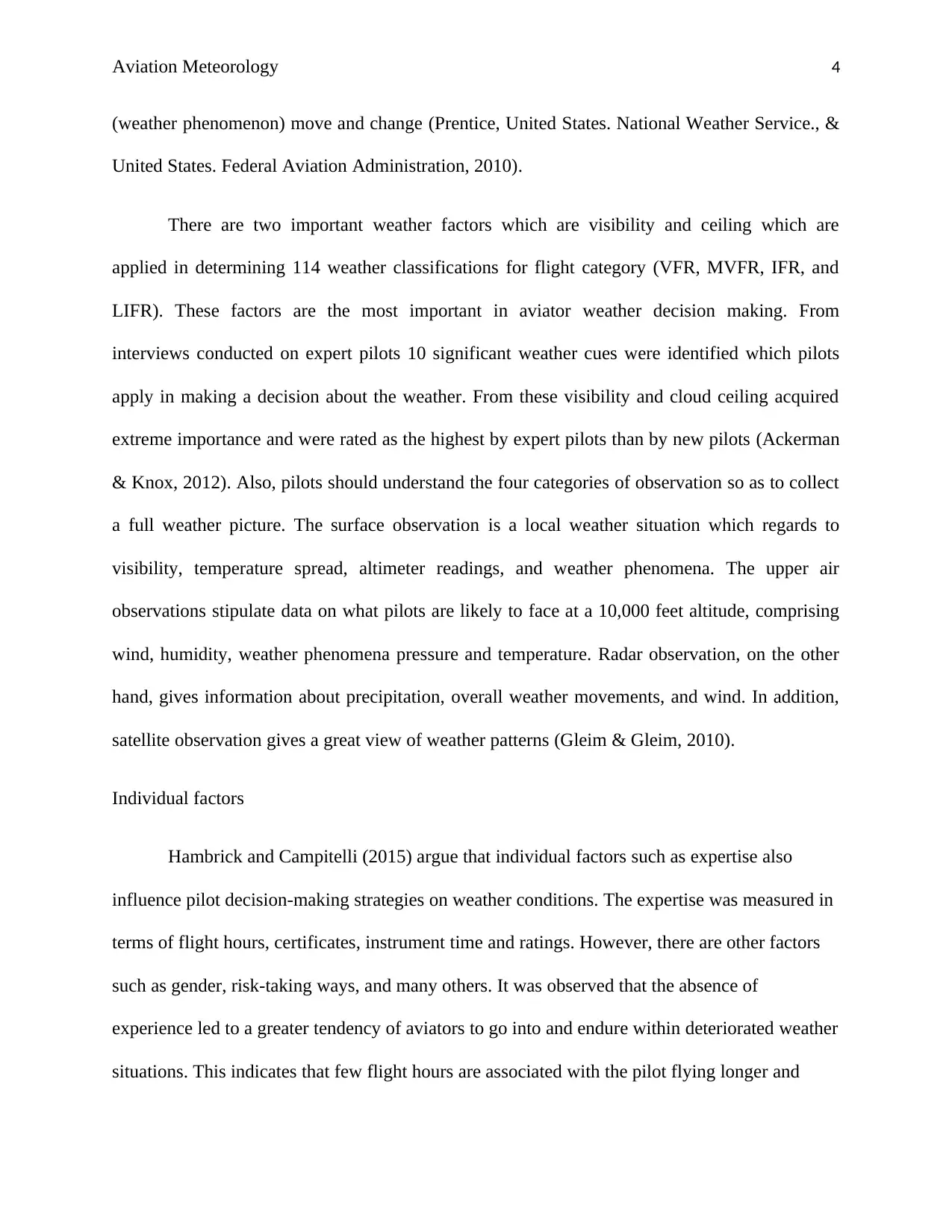
Aviation Meteorology 4
(weather phenomenon) move and change (Prentice, United States. National Weather Service., &
United States. Federal Aviation Administration, 2010).
There are two important weather factors which are visibility and ceiling which are
applied in determining 114 weather classifications for flight category (VFR, MVFR, IFR, and
LIFR). These factors are the most important in aviator weather decision making. From
interviews conducted on expert pilots 10 significant weather cues were identified which pilots
apply in making a decision about the weather. From these visibility and cloud ceiling acquired
extreme importance and were rated as the highest by expert pilots than by new pilots (Ackerman
& Knox, 2012). Also, pilots should understand the four categories of observation so as to collect
a full weather picture. The surface observation is a local weather situation which regards to
visibility, temperature spread, altimeter readings, and weather phenomena. The upper air
observations stipulate data on what pilots are likely to face at a 10,000 feet altitude, comprising
wind, humidity, weather phenomena pressure and temperature. Radar observation, on the other
hand, gives information about precipitation, overall weather movements, and wind. In addition,
satellite observation gives a great view of weather patterns (Gleim & Gleim, 2010).
Individual factors
Hambrick and Campitelli (2015) argue that individual factors such as expertise also
influence pilot decision-making strategies on weather conditions. The expertise was measured in
terms of flight hours, certificates, instrument time and ratings. However, there are other factors
such as gender, risk-taking ways, and many others. It was observed that the absence of
experience led to a greater tendency of aviators to go into and endure within deteriorated weather
situations. This indicates that few flight hours are associated with the pilot flying longer and
(weather phenomenon) move and change (Prentice, United States. National Weather Service., &
United States. Federal Aviation Administration, 2010).
There are two important weather factors which are visibility and ceiling which are
applied in determining 114 weather classifications for flight category (VFR, MVFR, IFR, and
LIFR). These factors are the most important in aviator weather decision making. From
interviews conducted on expert pilots 10 significant weather cues were identified which pilots
apply in making a decision about the weather. From these visibility and cloud ceiling acquired
extreme importance and were rated as the highest by expert pilots than by new pilots (Ackerman
& Knox, 2012). Also, pilots should understand the four categories of observation so as to collect
a full weather picture. The surface observation is a local weather situation which regards to
visibility, temperature spread, altimeter readings, and weather phenomena. The upper air
observations stipulate data on what pilots are likely to face at a 10,000 feet altitude, comprising
wind, humidity, weather phenomena pressure and temperature. Radar observation, on the other
hand, gives information about precipitation, overall weather movements, and wind. In addition,
satellite observation gives a great view of weather patterns (Gleim & Gleim, 2010).
Individual factors
Hambrick and Campitelli (2015) argue that individual factors such as expertise also
influence pilot decision-making strategies on weather conditions. The expertise was measured in
terms of flight hours, certificates, instrument time and ratings. However, there are other factors
such as gender, risk-taking ways, and many others. It was observed that the absence of
experience led to a greater tendency of aviators to go into and endure within deteriorated weather
situations. This indicates that few flight hours are associated with the pilot flying longer and
Paraphrase This Document
Need a fresh take? Get an instant paraphrase of this document with our AI Paraphraser
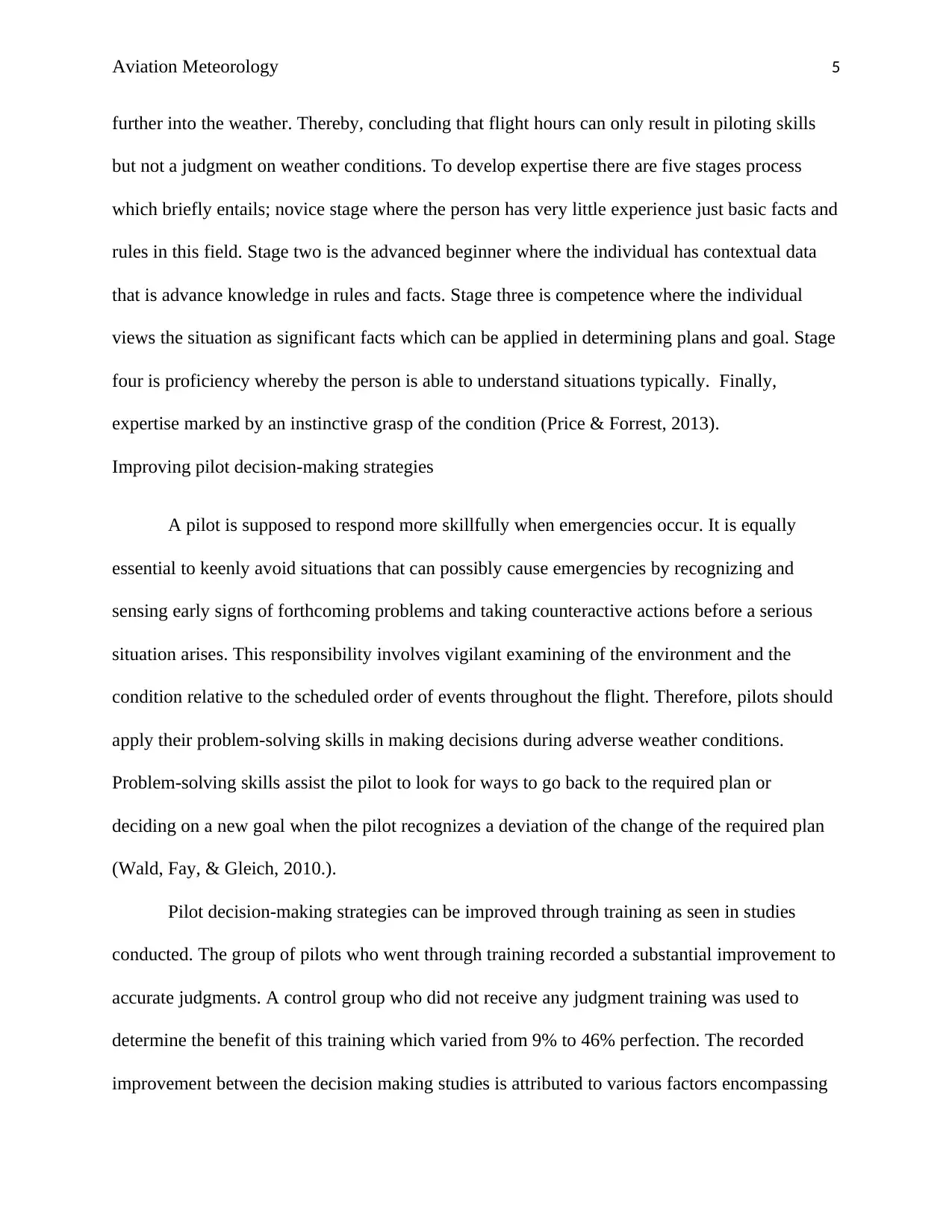
Aviation Meteorology 5
further into the weather. Thereby, concluding that flight hours can only result in piloting skills
but not a judgment on weather conditions. To develop expertise there are five stages process
which briefly entails; novice stage where the person has very little experience just basic facts and
rules in this field. Stage two is the advanced beginner where the individual has contextual data
that is advance knowledge in rules and facts. Stage three is competence where the individual
views the situation as significant facts which can be applied in determining plans and goal. Stage
four is proficiency whereby the person is able to understand situations typically. Finally,
expertise marked by an instinctive grasp of the condition (Price & Forrest, 2013).
Improving pilot decision-making strategies
A pilot is supposed to respond more skillfully when emergencies occur. It is equally
essential to keenly avoid situations that can possibly cause emergencies by recognizing and
sensing early signs of forthcoming problems and taking counteractive actions before a serious
situation arises. This responsibility involves vigilant examining of the environment and the
condition relative to the scheduled order of events throughout the flight. Therefore, pilots should
apply their problem-solving skills in making decisions during adverse weather conditions.
Problem-solving skills assist the pilot to look for ways to go back to the required plan or
deciding on a new goal when the pilot recognizes a deviation of the change of the required plan
(Wald, Fay, & Gleich, 2010.).
Pilot decision-making strategies can be improved through training as seen in studies
conducted. The group of pilots who went through training recorded a substantial improvement to
accurate judgments. A control group who did not receive any judgment training was used to
determine the benefit of this training which varied from 9% to 46% perfection. The recorded
improvement between the decision making studies is attributed to various factors encompassing
further into the weather. Thereby, concluding that flight hours can only result in piloting skills
but not a judgment on weather conditions. To develop expertise there are five stages process
which briefly entails; novice stage where the person has very little experience just basic facts and
rules in this field. Stage two is the advanced beginner where the individual has contextual data
that is advance knowledge in rules and facts. Stage three is competence where the individual
views the situation as significant facts which can be applied in determining plans and goal. Stage
four is proficiency whereby the person is able to understand situations typically. Finally,
expertise marked by an instinctive grasp of the condition (Price & Forrest, 2013).
Improving pilot decision-making strategies
A pilot is supposed to respond more skillfully when emergencies occur. It is equally
essential to keenly avoid situations that can possibly cause emergencies by recognizing and
sensing early signs of forthcoming problems and taking counteractive actions before a serious
situation arises. This responsibility involves vigilant examining of the environment and the
condition relative to the scheduled order of events throughout the flight. Therefore, pilots should
apply their problem-solving skills in making decisions during adverse weather conditions.
Problem-solving skills assist the pilot to look for ways to go back to the required plan or
deciding on a new goal when the pilot recognizes a deviation of the change of the required plan
(Wald, Fay, & Gleich, 2010.).
Pilot decision-making strategies can be improved through training as seen in studies
conducted. The group of pilots who went through training recorded a substantial improvement to
accurate judgments. A control group who did not receive any judgment training was used to
determine the benefit of this training which varied from 9% to 46% perfection. The recorded
improvement between the decision making studies is attributed to various factors encompassing
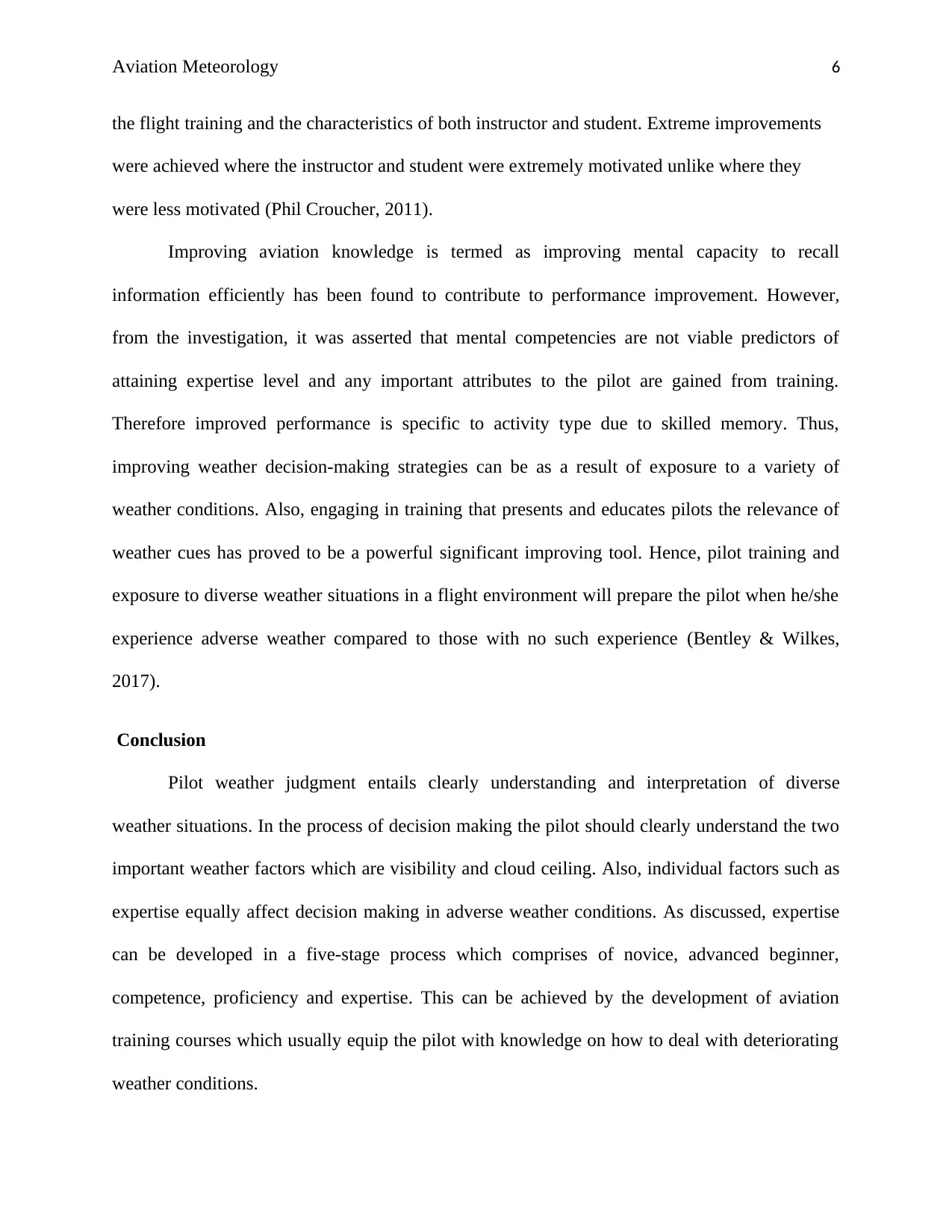
Aviation Meteorology 6
the flight training and the characteristics of both instructor and student. Extreme improvements
were achieved where the instructor and student were extremely motivated unlike where they
were less motivated (Phil Croucher, 2011).
Improving aviation knowledge is termed as improving mental capacity to recall
information efficiently has been found to contribute to performance improvement. However,
from the investigation, it was asserted that mental competencies are not viable predictors of
attaining expertise level and any important attributes to the pilot are gained from training.
Therefore improved performance is specific to activity type due to skilled memory. Thus,
improving weather decision-making strategies can be as a result of exposure to a variety of
weather conditions. Also, engaging in training that presents and educates pilots the relevance of
weather cues has proved to be a powerful significant improving tool. Hence, pilot training and
exposure to diverse weather situations in a flight environment will prepare the pilot when he/she
experience adverse weather compared to those with no such experience (Bentley & Wilkes,
2017).
Conclusion
Pilot weather judgment entails clearly understanding and interpretation of diverse
weather situations. In the process of decision making the pilot should clearly understand the two
important weather factors which are visibility and cloud ceiling. Also, individual factors such as
expertise equally affect decision making in adverse weather conditions. As discussed, expertise
can be developed in a five-stage process which comprises of novice, advanced beginner,
competence, proficiency and expertise. This can be achieved by the development of aviation
training courses which usually equip the pilot with knowledge on how to deal with deteriorating
weather conditions.
the flight training and the characteristics of both instructor and student. Extreme improvements
were achieved where the instructor and student were extremely motivated unlike where they
were less motivated (Phil Croucher, 2011).
Improving aviation knowledge is termed as improving mental capacity to recall
information efficiently has been found to contribute to performance improvement. However,
from the investigation, it was asserted that mental competencies are not viable predictors of
attaining expertise level and any important attributes to the pilot are gained from training.
Therefore improved performance is specific to activity type due to skilled memory. Thus,
improving weather decision-making strategies can be as a result of exposure to a variety of
weather conditions. Also, engaging in training that presents and educates pilots the relevance of
weather cues has proved to be a powerful significant improving tool. Hence, pilot training and
exposure to diverse weather situations in a flight environment will prepare the pilot when he/she
experience adverse weather compared to those with no such experience (Bentley & Wilkes,
2017).
Conclusion
Pilot weather judgment entails clearly understanding and interpretation of diverse
weather situations. In the process of decision making the pilot should clearly understand the two
important weather factors which are visibility and cloud ceiling. Also, individual factors such as
expertise equally affect decision making in adverse weather conditions. As discussed, expertise
can be developed in a five-stage process which comprises of novice, advanced beginner,
competence, proficiency and expertise. This can be achieved by the development of aviation
training courses which usually equip the pilot with knowledge on how to deal with deteriorating
weather conditions.
⊘ This is a preview!⊘
Do you want full access?
Subscribe today to unlock all pages.

Trusted by 1+ million students worldwide
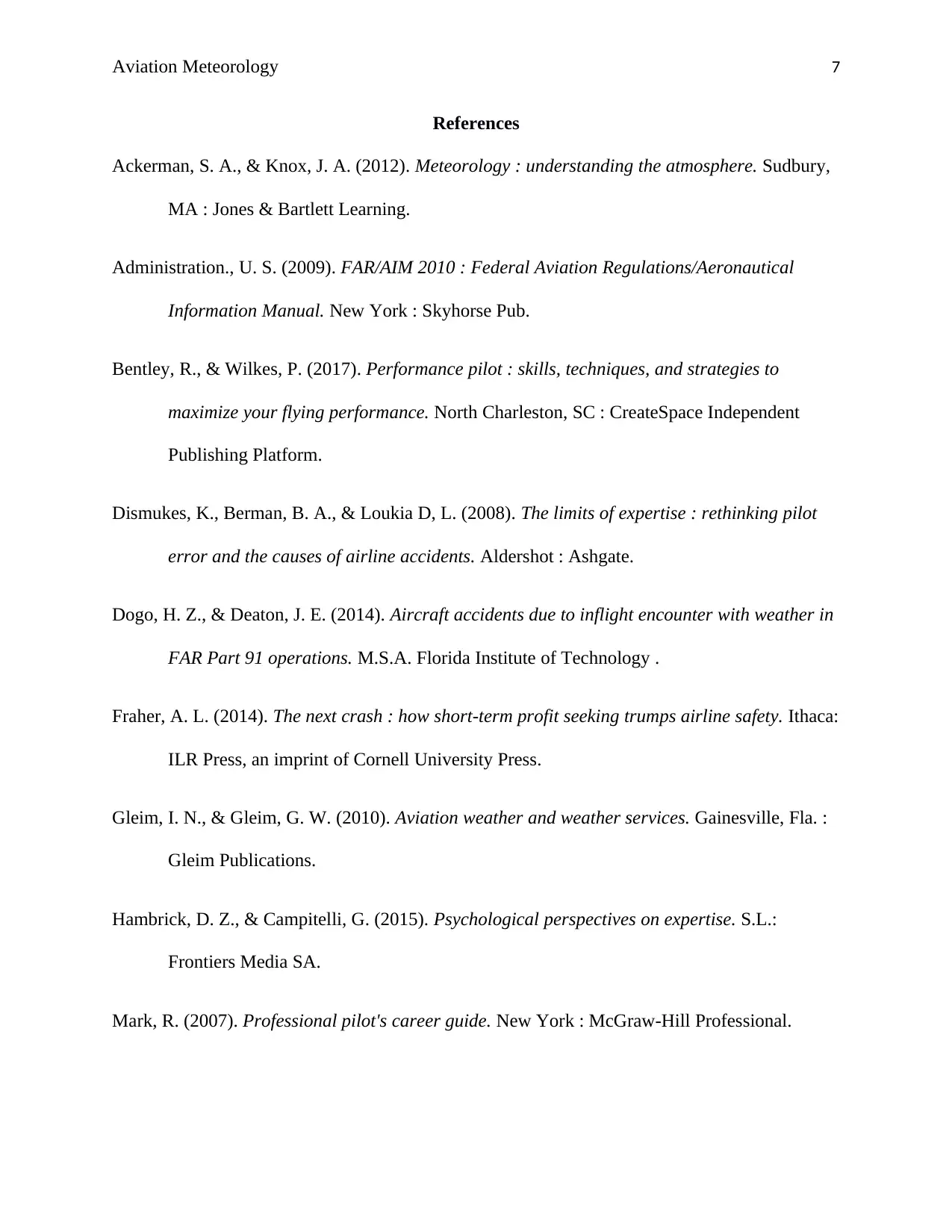
Aviation Meteorology 7
References
Ackerman, S. A., & Knox, J. A. (2012). Meteorology : understanding the atmosphere. Sudbury,
MA : Jones & Bartlett Learning.
Administration., U. S. (2009). FAR/AIM 2010 : Federal Aviation Regulations/Aeronautical
Information Manual. New York : Skyhorse Pub.
Bentley, R., & Wilkes, P. (2017). Performance pilot : skills, techniques, and strategies to
maximize your flying performance. North Charleston, SC : CreateSpace Independent
Publishing Platform.
Dismukes, K., Berman, B. A., & Loukia D, L. (2008). The limits of expertise : rethinking pilot
error and the causes of airline accidents. Aldershot : Ashgate.
Dogo, H. Z., & Deaton, J. E. (2014). Aircraft accidents due to inflight encounter with weather in
FAR Part 91 operations. M.S.A. Florida Institute of Technology .
Fraher, A. L. (2014). The next crash : how short-term profit seeking trumps airline safety. Ithaca:
ILR Press, an imprint of Cornell University Press.
Gleim, I. N., & Gleim, G. W. (2010). Aviation weather and weather services. Gainesville, Fla. :
Gleim Publications.
Hambrick, D. Z., & Campitelli, G. (2015). Psychological perspectives on expertise. S.L.:
Frontiers Media SA.
Mark, R. (2007). Professional pilot's career guide. New York : McGraw-Hill Professional.
References
Ackerman, S. A., & Knox, J. A. (2012). Meteorology : understanding the atmosphere. Sudbury,
MA : Jones & Bartlett Learning.
Administration., U. S. (2009). FAR/AIM 2010 : Federal Aviation Regulations/Aeronautical
Information Manual. New York : Skyhorse Pub.
Bentley, R., & Wilkes, P. (2017). Performance pilot : skills, techniques, and strategies to
maximize your flying performance. North Charleston, SC : CreateSpace Independent
Publishing Platform.
Dismukes, K., Berman, B. A., & Loukia D, L. (2008). The limits of expertise : rethinking pilot
error and the causes of airline accidents. Aldershot : Ashgate.
Dogo, H. Z., & Deaton, J. E. (2014). Aircraft accidents due to inflight encounter with weather in
FAR Part 91 operations. M.S.A. Florida Institute of Technology .
Fraher, A. L. (2014). The next crash : how short-term profit seeking trumps airline safety. Ithaca:
ILR Press, an imprint of Cornell University Press.
Gleim, I. N., & Gleim, G. W. (2010). Aviation weather and weather services. Gainesville, Fla. :
Gleim Publications.
Hambrick, D. Z., & Campitelli, G. (2015). Psychological perspectives on expertise. S.L.:
Frontiers Media SA.
Mark, R. (2007). Professional pilot's career guide. New York : McGraw-Hill Professional.
Paraphrase This Document
Need a fresh take? Get an instant paraphrase of this document with our AI Paraphraser
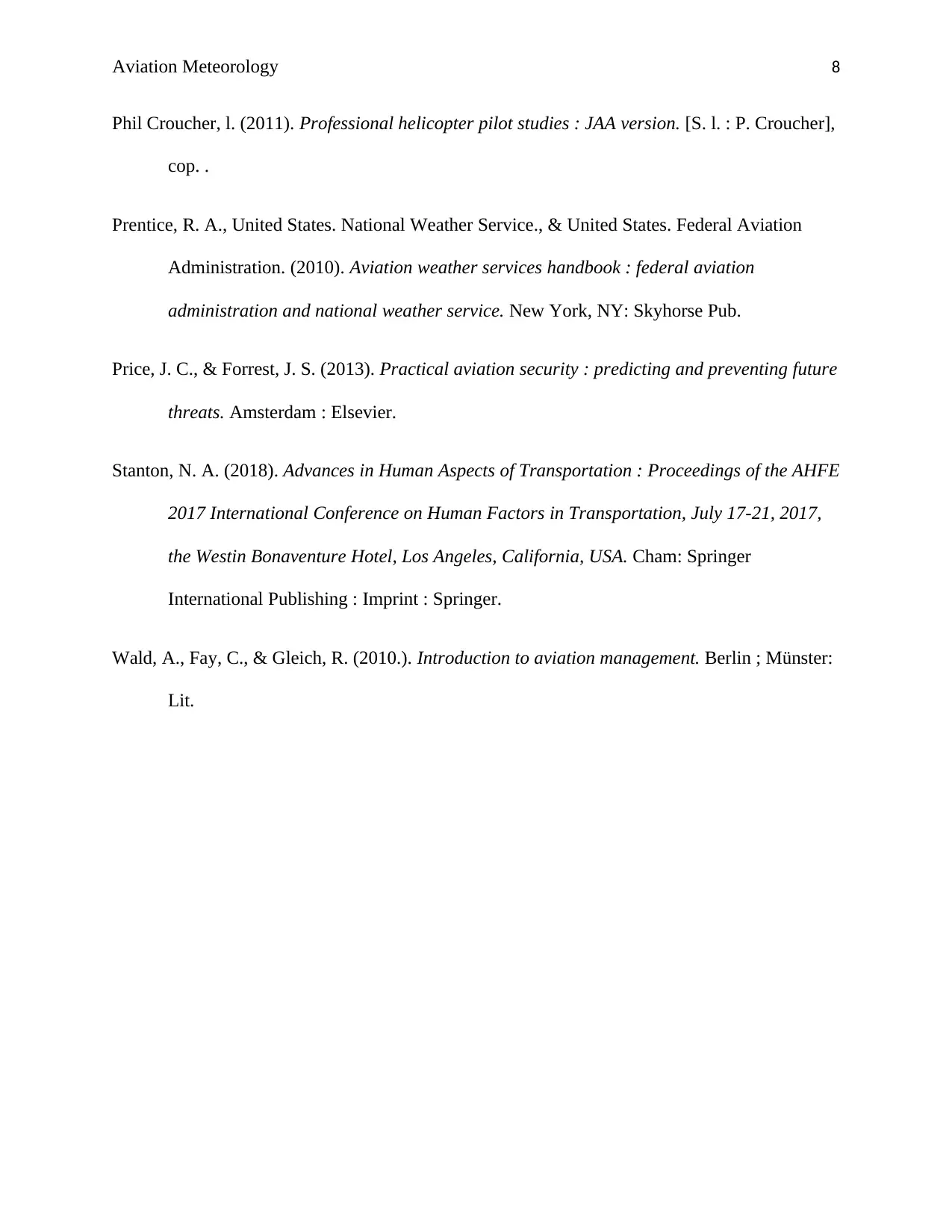
Aviation Meteorology 8
Phil Croucher, l. (2011). Professional helicopter pilot studies : JAA version. [S. l. : P. Croucher],
cop. .
Prentice, R. A., United States. National Weather Service., & United States. Federal Aviation
Administration. (2010). Aviation weather services handbook : federal aviation
administration and national weather service. New York, NY: Skyhorse Pub.
Price, J. C., & Forrest, J. S. (2013). Practical aviation security : predicting and preventing future
threats. Amsterdam : Elsevier.
Stanton, N. A. (2018). Advances in Human Aspects of Transportation : Proceedings of the AHFE
2017 International Conference on Human Factors in Transportation, July 17-21, 2017,
the Westin Bonaventure Hotel, Los Angeles, California, USA. Cham: Springer
International Publishing : Imprint : Springer.
Wald, A., Fay, C., & Gleich, R. (2010.). Introduction to aviation management. Berlin ; Münster:
Lit.
Phil Croucher, l. (2011). Professional helicopter pilot studies : JAA version. [S. l. : P. Croucher],
cop. .
Prentice, R. A., United States. National Weather Service., & United States. Federal Aviation
Administration. (2010). Aviation weather services handbook : federal aviation
administration and national weather service. New York, NY: Skyhorse Pub.
Price, J. C., & Forrest, J. S. (2013). Practical aviation security : predicting and preventing future
threats. Amsterdam : Elsevier.
Stanton, N. A. (2018). Advances in Human Aspects of Transportation : Proceedings of the AHFE
2017 International Conference on Human Factors in Transportation, July 17-21, 2017,
the Westin Bonaventure Hotel, Los Angeles, California, USA. Cham: Springer
International Publishing : Imprint : Springer.
Wald, A., Fay, C., & Gleich, R. (2010.). Introduction to aviation management. Berlin ; Münster:
Lit.
1 out of 8
Your All-in-One AI-Powered Toolkit for Academic Success.
+13062052269
info@desklib.com
Available 24*7 on WhatsApp / Email
![[object Object]](/_next/static/media/star-bottom.7253800d.svg)
Unlock your academic potential
Copyright © 2020–2026 A2Z Services. All Rights Reserved. Developed and managed by ZUCOL.